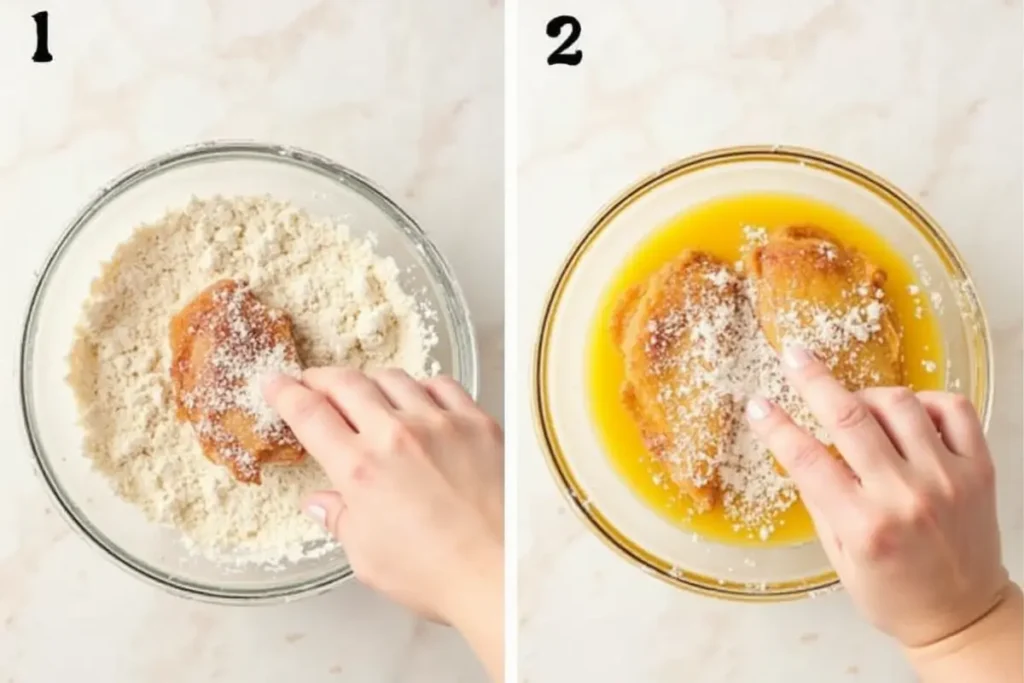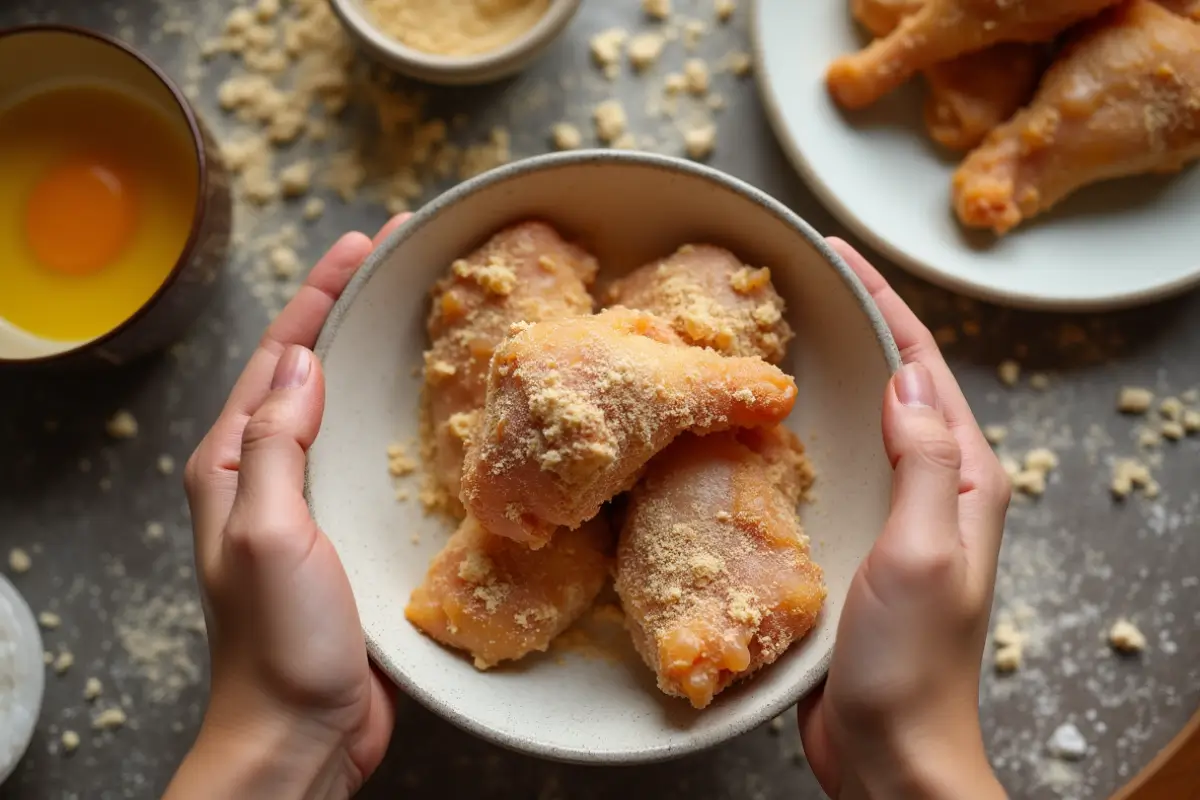Have you ever found yourself standing in your kitchen, a flurry of flour swirling around you, a chicken piece in one hand, and wondering if you’ve been doing this fried chicken thing wrong your entire life? It’s a feeling that’s all too familiar, in fact, it’s a silent kitchen debate that has spanned generations: “Do you do egg or flour first for fried chicken?” This seemingly simple question has divided families, sparked passionate discussions, and even kept home cooks awake at night, tossing and turning in search of the ultimate crispy chicken.
Fortunately, there’s no single “right” answer! However, depending on which method you choose, each has a specific effect on the outcome of your fried chicken. Therefore, this article will take you on a journey into the science and technique of creating the best fried chicken. We’ll explore the pros and cons of each method, along with essential tips to guarantee your next batch is nothing short of spectacular!
The Case for Flour First: A Foundation for Crispiness
Let’s begin by looking into the case for flour first. This is not just some random act, but rather, a calculated step rooted in food science. Specifically, picture this: you have raw chicken, and then you immediately cover it in flour. What’s the point, you may ask? Well, the dry flour acts as a fantastic base. In short, it readily absorbs any moisture on the surface of your chicken piece, creating a more even and secure grip for the next layer – the egg.
Why is this so important? Clearly, this foundational layer is crucial for achieving a crispier crust. Think of it like preparing a surface before painting. You wouldn’t, for example, start painting on a wet, oily wall. Similarly, this flour layer sets the stage for the egg wash to properly cling and, consequently, the next layer of flour.
Furthermore, when you apply flour directly to the chicken, the flour absorbs excess moisture right from the source. Less moisture on the chicken therefore translates to less steam while frying, which in turn, allows the outer layer to crisp up perfectly instead of becoming soggy. In essence, this is the main trick for getting that desired crunchy crust on the outside.
Additionally, various sources, such as seasoned food science experts and chefs, vouch for this method. Indeed, they emphasize that getting the base right by ensuring maximum adhesion is the key to achieving crispy fried chicken.
The Case for Egg First: A Maximized Coating
Now, let’s move to the other side of the frying pan: the egg-first enthusiasts. So, if you’re in this camp, you might be nodding in agreement. In fact, applying egg wash directly to chicken, before the flour, is rooted in a different perspective. For you, it is all about the binding power of the egg.
Essentially, when an egg meets chicken, it’s a match made in coating heaven. The egg wash acts like glue, ensuring the flour sticks to your chicken like a second skin, especially on those tricky uneven surfaces of the chicken. If your chicken piece has some nooks and crannies, then the egg-first method ensures no area is left un-coated.
Moreover, this approach allows for the building of a thicker coating, which many people swear by for extra crunch. Thus, when you create the thicker coating, the resulting fried chicken will not only be more flavorful, but also you will get the satisfying crunch in every bite that you crave.
Although many love this method, there is no denying the science behind flour first, but many chefs and home cooks prefer this method as it’s effective and has a better result. However, like all techniques, it requires practice and experience to achieve mastery.
The Complete Guide to Double Dipping for Fried Chicken
Now, for a more elaborate method. If, indeed, you’re aiming for fried chicken that is next-level delicious, then you should explore double dipping. This method involves coating your chicken not once, but twice, thereby leading to a super crispy, flavorful crust that is hard to resist.
What is Double Dipping?
Basically, double dipping means you’ll be coating your chicken twice in both the wet and dry ingredients. This gives the chicken an extra layer of protection and flavor. You will begin by dipping your chicken in either flour or egg as the first step and then you will follow the next steps twice.
How it Impacts Flavor and Texture?
Double dipping does more than just add another layer of coating; it actually locks in the chicken’s juices and provides an incredible texture. The first layer is a preparatory step, creating a base. The second layer builds on it. When this double coated chicken is fried, the multiple layers create a wonderful crunch while keeping the inside tender and juicy.
Best practices:
- Firstly, don’t rush the process.
- Secondly, ensure every inch of the chicken is covered in both the dry and wet coatings.
- Thirdly, use a cooling rack to allow excess coating to fall.
- Lastly, Fry in batches, allowing the oil to reach temperature after adding each batch.
By implementing double dipping, you will get the most professional-like crispy chicken at home. This method is commonly used in restaurants for a reason.
Recipe for Perfectly Crispy Fried Chicken (Double Dipping Method)

Now, let’s get practical. Here’s a foolproof recipe for perfectly crispy fried chicken utilizing the double dipping method:
| Ingredient | Quantity |
| Chicken Pieces | 8 (drumsticks, thighs) |
| All-Purpose Flour | 2 cups |
| Eggs | 2 |
| Milk/Buttermilk | 1/2 cup |
| Salt | 1 tsp |
| Black Pepper | 1/2 tsp |
| Garlic Powder | 1 tsp |
| Paprika | 1/2 tsp |
| Cooking Oil (Vegetable, Canola, Sunflower) | Enough for deep frying |
Instructions:
- Prepare your chicken: First, ensure your chicken pieces are dry. Pat them with paper towels to get rid of any excess moisture.
- Set up your bowls: Next, in one bowl, whisk together the eggs and milk/buttermilk. In a separate bowl, combine the flour, salt, pepper, garlic powder, and paprika.
- First Flour Dip: Afterwards, dip each chicken piece into the flour mixture. Make sure they are completely coated, and then shake off the excess.
- First Egg Dip: Following this, dip the floured chicken pieces into the egg mixture, ensuring they are fully saturated.
- Second Flour Dip: Then, take the chicken from the egg mixture and dip it into the flour mixture again, creating the second layer. Press the flour coating with your fingers to make sure it sticks to the chicken. Shake off any excess flour.
- Repeat egg and flour dip (Optional): Subsequently, repeat this process by dipping in the egg and flour mixture one more time, this is only necessary if you like a very thick crust on your fried chicken.
- Heat Your Oil: Next, fill a deep, heavy-bottomed pot or skillet with cooking oil. Heat it over medium-high heat. Use a thermometer to ensure the oil is heated to 325-350°F (160-175°C).
- Fry the Chicken: Now, carefully place the chicken pieces into the hot oil, ensuring you don’t overcrowd the pan. Fry in batches to maintain the oil temperature. Fry for about 12-15 minutes per side, until golden brown and cooked through. The internal temperature of the chicken should reach 165°F (74°C).
- Rest the Chicken: Finally, take the chicken out of the hot oil and place it on a wire rack to drain excess oil. Let it rest for a few minutes before serving.
Optional add-ons:
- Indeed, if you have some cornstarch at home, you can add two tablespoons to your flour mixture, for an extra layer of crispiness.
- Furthermore, for a spicier taste, add some cayenne pepper to your seasoning.
Safety Notes: Always, use caution when deep-frying. Ensure the oil does not overheat, and don’t overcrowd the pan to avoid oil spillage.
The Role of Breading and Seasoning
Clearly, the breading and seasoning are equally as important as the dipping method you choose. They influence the flavor, texture and overall experience of your fried chicken. Furthermore, they matter just as much as the question of do you do egg or flour first for fried chicken.
Types of Breading
While regular all-purpose flour is the most common ingredient, there are several other options you can explore to achieve different textures. For example, cornstarch adds an extra layer of crispiness to the crust. Moreover, you can also use bread crumbs for a more rustic texture.
Seasoning Options
The seasoning you use in your breading can completely transform the taste of your fried chicken. Aside from the standard salt and pepper, consider using garlic powder, onion powder, paprika, and cayenne pepper. Consequently, get creative, use a mix of different herbs and spices to match your taste.
Seasoning Timing
Indeed, many people argue about when the best time to season is. Some believe that seasoning the flour mixture is better to give the chicken a more even flavor while others prefer to season the eggs for the same reason. Since both methods are valid, therefore, this process depends on personal preference. So if you’re still wondering do you do egg or flour first for fried chicken, seasoning is a valid consideration.
Expert Tips for the Best Fried Chicken

Here are some expert tips that can really improve your fried chicken skills:
- Oil Temperature: Firstly, maintain a consistent oil temperature (325-350°F / 160-175°C) using a cooking thermometer to ensure your chicken cooks evenly. Too low oil temperature will make the chicken greasy and soggy, while, oil that is too hot can burn the outside of the chicken while leaving the inside raw.
- Don’t Overcrowd: Secondly, fry the chicken in batches, avoiding overcrowding the pan. Overcrowding can lower the oil temperature, thereby leading to uneven and greasy chicken.
- Resting Time: Thirdly, place your freshly fried chicken on a wire rack to rest and drain any excess oil, ensuring a crispy crust. The resting period also allows the chicken to retain its juices and flavor.
- Brining: Finally, if you have the time, try brining the chicken for a few hours or overnight. Brining will give a significant upgrade to the texture and flavor of the chicken.
Common Mistakes to Avoid When Frying Chicken
To achieve the most crispy fried chicken, it’s important to avoid these common mistakes that are made while frying chicken:
- Low Oil Temperature: Firstly, frying the chicken in low oil temperature will make the chicken oily and undercooked. Use a thermometer and make sure the oil is hot enough before you begin frying.
- Overcrowding the Pan: Secondly, avoid overcrowding the frying pan when frying. When you overcrowd the pan, the oil temperature will drop and the fried chicken will not have the expected result.
- Improper Seasoning: Thirdly, under or over-seasoning can also affect your fried chicken. Ensure you’re using the right amount of spices that matches your taste.
- Incorrect Frying Time: Finally, frying the chicken for too short or too long will result in either raw or dry chicken, which is undesirable. Use a thermometer to make sure the chicken is cooked to the right temperature before taking it out of the oil.
Perfect Side Dishes to Pair with Fried Chicken
Fried chicken is a beloved comfort food, known for its crispy texture and savory flavor. However, pairing it with the right sides can elevate the meal into a well-rounded feast. Here are some excellent options:
1. Baked Beans
To begin with, baked beans are a classic side dish that pairs beautifully with the rich flavors of fried chicken. Their smoky and slightly sweet taste complements the savory crunch of the chicken. Try the Baked Beans Recipe for an easy-to-make option.
2. Buttery Biscuits or Flatbreads
Adding warm, buttery biscuits or soft flatbreads can enhance your meal. For a unique twist, serve Cottage Cheese Flatbread, which adds a creamy and tangy element to the plate.
3. Seasoned Rice Dishes
Seasoned rice, such as a garlic butter rice or pilaf, makes a hearty side dish for fried chicken. For quick preparation, check out Rice Cooker Meals for flavorful ideas.
4. Fresh Salads
Balancing the richness of fried chicken with a crisp green salad or coleslaw is always a great idea. A tangy vinaigrette or creamy dressing adds a refreshing contrast.
5. Vegetable Sides
Roasted or steamed vegetables, such as green beans, asparagus, or corn on the cob, are excellent complements to fried chicken. Adding a squeeze of lemon or a sprinkle of herbs can elevate the flavors.
6. Flavor Pairing Ideas
For those who enjoy experimenting with flavors, explore Lemon Pepper Wings for seasoning ideas that can complement fried chicken or inspire similar dishes.
7. Cooking Tips
If you’re curious about techniques for achieving the crispiest fried chicken, take inspiration from What Is the Secret Ingredient to Crispy Wings?. These tips can also apply to fried chicken recipes.
By pairing fried chicken with these sides, you can create a meal that is not only satisfying but also full of flavor and variety. Whether for a family dinner or a gathering, these combinations are sure to please everyone at the table!
FAQ: Do you do egg or flour first for fried chicken?
Here are some frequently asked questions to help you understand the topic and clarify any doubts:
- What’s the big deal about whether you do egg or flour first for fried chicken?
- Essentially, the order impacts how the coating adheres to the chicken and the final texture. Flour first creates a base for the egg to stick, potentially leading to crispier results. Egg first helps the flour stick well, and gives a thicker coating.
- Does it really matter if I do egg or flour first for fried chicken?
- Yes, it does, but not as much as you think. It’s mostly a matter of preference. Indeed, both methods can lead to delicious fried chicken, but with slightly different results.
- Can I use both methods when making fried chicken?
- Absolutely! Double-dipping is very effective and will add an extra layer of flavor and texture to your chicken.
- What kind of oil is best for frying chicken?
- Oils with a high smoke point, such as vegetable, canola, or sunflower oil, are best for frying chicken. These oils can withstand high temperatures without breaking down.
- What’s the best temperature for frying chicken?
- It is recommended to keep the oil temperature around 325-350°F (160-175°C). This range ensures that the chicken is cooked through and the crust is golden brown.
Conclusion
So, “Do you do egg or flour first for fried chicken?” Ultimately, the answer is, it depends on what you’re trying to achieve and your personal preference. The flour-first method provides an excellent base for a crispy, less soggy coating, while, the egg-first method helps to create a thicker, crunchier crust. However, the most optimal method for achieving the most perfect crispy fried chicken at home is by double dipping.
Ultimately, the best way for you to master the art of fried chicken is to experiment with both methods and find what works best for your taste and cooking style. Moreover, what matters most is the love and effort you put into your cooking. Embrace your kitchen experiments, learn from any mistakes you may make, and most importantly, enjoy the process. And with that, may your next fried chicken be the best one yet!
Now that you’ve discovered all of the tips and tricks, what will be the method that you’ll use? Don’t hesitate to share your experience with us, and be sure to share this article with all your friends and family to let them know how to fry the perfect chicken!

